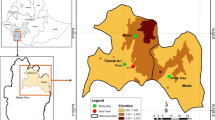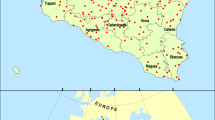Abstract
This study evaluates the relevance of wild-growing vegetables in two villages of the Honde Valley, Zimbabwe, by documenting the use, knowledge of, and attitudes toward these plants. Information on plant use was gathered through 20 food diaries, 8 focus group discussions, and semi-structured interviews with 76 individuals (32 male) from the villages. Forty-two ethnospecies of wild vegetables were recorded and 26 identified to species. Wild leafy vegetables were consumed about twice a week by participating families; Cleome gynandra and Bidens pilosa were eaten most frequently. Preferred vegetables were dried and conserved for off-season use. Knowledge of wild food plants was transmitted orally within families, acquired in early childhood, and gradually increased with age. Gender differences were found in the quantity and type of knowledge. According to the villagers, the advantages of wild vegetables were their nutritional and economic value, as well as their accessibility. The perceived drawbacks were mainly related to quality issues, strong tastes, and lack of year-round availability. Despite preference for cultivated alternatives among younger people, there was renewed interest in wild plants due to recent health concerns such as diabetes and HIV.





Similar content being viewed by others
Literature Cited
Abbasi, A. M., M. H. Shah, T. Li, X. Fu, X. Guo, and R. H. Liu. 2015. Ethnomedicinal values, phenolic contents and antioxidant properties of wild culinary vegetables. Journal of Ethnopharmacology 162:333–345.
Agudo, A. 2005. Measuring intake of fruit and vegetables. Background Paper for the Joint FAO/WHO Workshop on Fruit and Vegetables for Health, 2004, Kobe, Japan. WHO, Electronic Resource. http://www.who.int/dietphysicalactivity/publications/f&v_intake_measurement.pdf (March 2018).
Altieri, M. A., M. Anderson, and L. C. Merrick. 1987. Peasant agriculture and the conservation of crop and wild plant resources. Conservation Biology 1(1):49–58.
Anderson, I. P., P. J. Brinn, M. Moyo, and B. Nyamwanza. 1993. Physical resource inventory of the Communal Lands of Zimbabwe—An overview (NRI Bulletin 60). Chatham, UK: Natural Resources Institute.
Bussmann, R. W., N. Y. Paniagua-Zambrana, N. Wood, S. O. Njapit, J. N. O. Njapit, G. S. E. Osoi, and S. P. Kasoe. 2018. Knowledge loss and change between 2002 and 2017—A revisit of plant use of the Maasai of Sekenani Valley, Maasai Mara, Kenya. Economic Botany 72 (2):207–216.
Bvenura, C. and D. Sivakumar 2017. The role of wild fruits and vegetables in delivering a balanced and healthy diet. Food Research International 99:15–30.
Campbell, B., P. Frost, and N. Byron. 1996. Miombo woodlands and their use: Overview and key issues. In: The miombo in transition: Woodlands and welfare in Africa, ed., B. Campbell, 1–10. Bogor, Indonesia: Center for International Forestry Research (CIFOR).
Canales, M., T. Hernández, J. Caballero, A. R. De Vivar, G. Avila, A. Duran, and R. Lira. 2005. Informant consensus factor and antibacterial activity of the medicinal plants used by the people of San Rafael Coxcatlán, Puebla, México. Journal of Ethnopharmacology 97(3):429–439.
Chipurura, B., M. Muchuweti, W. Parawira, and A. Kasiyamhuru. 2009. An assessment of the phenolic content composition and antioxidant capacity of Bidens pilosa, Cleome gynandra, Corchorus olitorius, Galinsoga parviflora, and Amaranthus hybridus. I All Africa Horticultural Congress 911:417–426.
Dessalegn, A. A. 2017. Ethnobotanical survey of wild edible plants and their contribution for food security used by Gumuz people in Kamash Woreda; Benishangul Gumuz Regional State, Ethiopia. Journal of Food and Nutrition Sciences 5(6):217–224.
Dhewa, C. 2003. The old ones are the best. New Agriculturalist online. http://www.new-ag.info/03-5/focuson/focuson5.html (25 July 2007).
Flyman, M. V. and A. J. Afolayan. 2006. A survey of plants used as wild vegetables in four districts of Botswana. Ecology of Food and Nutrition 45(6):405–415.
Gonzalez-Amaro, R. M., A. Martinez-Bernal, F. Basurto-Peña, and H. Vibrans. 2009. Crop and non-crop productivity in a traditional maize agroecosystem of the highland of Mexico. Journal of Ethnobiology and Ethnomedicine 5:38. https://doi.org/10.1186/1746-4269-5-38.
Guarrera, P. M. and V. Savo. 2013. Perceived health properties of wild and cultivated food plants in local and popular traditions of Italy: A review. Journal of Ethnopharmacology 146(3):659–680.
Gwatirisa P. and L. Manderson. 2012. “Living from day to day”: Food insecurity, complexity, and coping in Mutare, Zimbabwe. Ecology of Food and Nutrition 51(2):97–113.
High, C. and C. M. Shackleton. 2000. The comparative value of wild and domestic plants in home gardens of a South African rural village. Agroforestry Systems 48(2):141–156.
Jensen van Rensburg, W. S., W. van Averbeke, R. Slabbert, M. Faber. P. van Jaarsveld, I. van Heerden, F. Wenhold, and A. Oelofse. 2007. African leafy vegetables in South Africa. Water SA 33(3):317–326.
Kalle, R. and R. Sõukand. 2016. Current and remembered past uses of wild food plants in Saaremaa, Estonia: Changes in the context of unlearning debt. Economic Botany 70(3):235–253.
Kaschula, S. A. 2008. Wild foods and household food security responses to AIDS: Evidence from South Africa. Population and Environment 29(3–5):162–185.
Kidane, B., L. J. G. Van der Maesen, Z. Asfaw, M. S. M. Sosef, and T. van Andel. 2015. Wild and semi-wild leafy vegetables used by the Maale and Ari ethnic communities in southern Ethiopia. Genetic Resources and Crop Evolution 62(2):221–234.
Machila, M., M. Lyne, and P. L. Nuthall. 2015. Assessment of an outsourced agricultural extension service in the Mutasa district of Zimbabwe. Journal of Agricultural Extension and Rural Development 7(5):142–149.
Madamombe-Manduna, I., H. Vibrans, and L. López-Mata. 2009b. Diversity of coevolved weeds in smallholder maize fields of Mexico and Zimbabwe. Biodiversity and Conservation 18(6):1589–1610.
———, ———, and V. V. García. 2009a. Género y conocimientos etnobotánicos en México y Zimbabwe. Un estudio comparativo. Sociedades Rurales, Producción y Medio Ambiente 6(18):21–48.
Makumbe, J. 2009. The impact of democracy in Zimbabwe: Assessing political, social and economic developments since the dawn of democracy. Research Report 119. Johannesburg, South Africa: Centre for Policy Studies.
Manduna, I. T. 2008. Etnobotánica comparativa de plantas comestibles recolectadas en sistemas de agricultura tradicional de México y Zimbabwe. http://colposdigital.colpos.mx:8080/jspui/handle/10521/1521 (18 June 2013).
Maroyi, A. 2011a. The gathering and consumption of wild edible plants in Nhema Communal Area, Midlands Province, Zimbabwe. Ecology of Food and Nutrition 50(6):506–525.
———. 2011b. Potential role of traditional vegetables in household food security: A case study from Zimbabwe. African Journal of Agricultural Research 6(26):5720–5728.
———. 2013. Use of weeds as traditional vegetables in Shurugwi District, Zimbabwe. Journal of Ethnobiology and Ethnomedicine 9(1):60. https://doi.org/10.1186/1746-4269-9-60.
McGregor, J. 1994. Gathered produce in Zimbabwe’s communal areas changing resource availability and use. Ecology of Food and Nutrition 33(3):163–193.
Melián, A., T. Rucabado, J. F. Sarabia, M. Á. Botella, A. D. Asencio, and M. T. Pretel. 2017. Cultural importance of wild or traditionally collected plants in the Sierra de Grazalema (Southern Spain). Economic Botany 71(2):160–174.
Momsen, J. H. 2007. Gender and agrobiodiversity: Introduction to the Special Issue. Singapore Journal of Tropical Geography 28(1):1–6.
Msuya, T. S., J. R. Kideghesho, and T. C. E. Mosha. 2010. Availability, preference, and consumption of indigenous forest foods in the Eastern Arc Mountains, Tanzania. Ecology of Food and Nutrition 49(3):208–227.
Narayanan, M. K. and N. A. Kumar. 2007. Gendered knowledge and changing trends in utilization of wild edible greens in Western Ghats, India. Indian Journal of Traditional Knowledge 6(1):204–216.
Ncube, K., C. M. Shackleton, B. M. Swallow, and W. Dassanayake. 2016. Impacts of HIV/AIDS on food consumption and wild food use in rural South Africa. Food Security 8(6):1135–1151.
Ong, H. G. and Y. D. Kim. 2017. The role of wild edible plants in household food security among transitioning hunter-gatherers: Evidence from the Philippines. Food Security 9(1):11–24.
Pieroni, A., R. Sõukand, C. L. Quave, A. Hajdari, and B. Mustafa. 2017. Traditional food uses of wild plants among the Gorani of South Kosovo. Appetite 108:83–92.
Pinela, J., A. M. Carvalho, and I. C. Ferreira. 2017. Wild edible plants: Nutritional and toxicological characteristics, retrieval strategies and importance for today’s society. Food and Chemical Toxicology 110:165–188.
Shackleton, C. M. 2003. The prevalence of the use and value of wild edible herbs in South Africa. South African Journal of Science 99:23–25.
Shackleton, S. E., C. M. Shackleton, T. R. Netshilivhi, B. S. Geach, A. Balance, and D. H. K. Fairbanks. 2002. Use patterns and value of savanna resources in three rural villages in South Africa. Economic Botany 56(2):130–146.
Shava, S. 2005. Research on indigenous knowledge and its application: A case of wild food plants of Zimbabwe. Southern African Journal of Environmental Education 22:73–86.
Singh, R. K., K. K. Zander, S. Kumar, A. Singh, P. Sheoran, A. Kumar, S. M. Hussain, T. Riba, O. Rallen, Y. J. Lego, and E. Padung. 2017. Perceptions of climate variability and livelihood adaptations relating to gender and wealth among the Adi community of the Eastern Indian Himalayas. Applied Geography 86:41–52.
Srithi, K., H. Balslev, W. Tanming, and C. Trisonthi. 2017. Weed diversity and uses: A case study from tea plantations in Northern Thailand. Economic Botany 71(2):147–159.
Teklehaymanot, T. and M. Giday. 2010. Ethnobotanical study of wild edible plants of Kara and Kwego semi-pastoralist people in Lower Omo River Valley, Debub Omo Zone, SNNPR, Ethiopia. Journal of Ethnobiology and Ethnomedicine 6:23. http://www.ethnobiomed.com/content/6/1/23. (30 October 2018).
World Health Organization. 2016. Zimbabwe Diabetes country profile: 2016. http://www.who.int/diabetes/country-profiles/zwe_en.pdf?ua=1 (30 November 2018).
———. 2017. Zimbabwe HIV country report: 2016. http://www.who.int/hiv/data/Country_profile_Zimbabwe.pdf (30 November 2018).
WWF (World Wildlife Fund). 2018. Zimbabwe, Mozambique Montane Grasslands & Shrublands Ecoregion. https://www.worldwildlife.org/ecoregions/at1006 (30 November 2018).
Acknowledgements
We would like to thank the people of Chipupuri and Maradzika for their participation in the study, as well as Mr. C. Chapano of the National Herbarium of Zimbabwe (SRGH) for his valuable assistance in the identification of plant specimens. The doctoral studies of the first author were supported by the Secretary of the Exterior of Mexico, and the fieldwork in Zimbabwe was financed privately by the two authors.
Author information
Authors and Affiliations
Corresponding author
Rights and permissions
About this article
Cite this article
Manduna, I., Vibrans, H. Consumption of Wild-Growing Vegetables in the Honde Valley, Zimbabwe. Econ Bot 72, 436–449 (2018). https://doi.org/10.1007/s12231-019-9441-y
Received:
Accepted:
Published:
Issue Date:
DOI: https://doi.org/10.1007/s12231-019-9441-y




